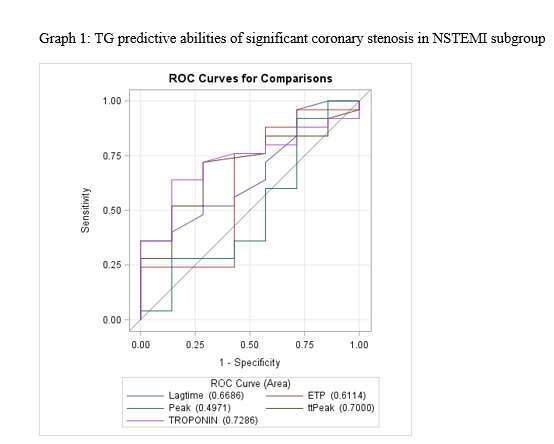
Thrombin Generation as a Predictor of Coronary Artery severity
2Heart Institute, Emek Medical Center, Afula, Israel
3Emergency Department, Emek Medical Center, Afula, Israel
4Bruce Rappaport Faculty of Medicine, Technion-Israel Institute of Technology, Haifa, Israel
Introduction:
Thrombin is involved in thrombus formation, platelet activation, and atherosclerosis, thereby possessing a central role in the formation of ischemic heart disease (IHD). Past research has found a correlation between thrombin generation (TG) tests and IHD, but the results have thus far been equivocal. Our aim in this study was to evaluate the efficacy of TG tests in estimating coronary stenosis severity by angiography.
Material and method:
In this prospective, single-center study, we recruited 128 patients with chest pain and/or acute coronary syndrome (ACS) planned for percutaneous coronary intervention. STEMI patients were excluded. TG values were calculated using Calibrated Automated Thrombogram prior to anticoagulation treatment and coronary angiography. Primary outcomes were defined as a significant coronary lesion on angiography and the syntax I score. Secondary outcome was Troponin T peak.
Results and discussion:
There was a significant correlation between Endogenous Thrombin Potential (ETP) and coronary stenosis in patients with previous IHD (p=0.03). In unstable angina patients, there was a statistically significant correlation between Peak thrombin and significant coronary stenosis (p=.03). In NSTEMI patients, the diagnostic ability to predict significant coronary stenosis by using TG was 70%. There was no significant correlation between TG parameters and coronary stenosis among patients presented with chest pain and without signs of myocardial injury. There was no correlation between syntax I score and TG parameters probably because the vast majority of patients were with a score of less than 22. Peak thrombin was positively correlated with troponin in patients with significant coronary stenosis (rho=.335, p=.01). Our results may indicate that TG may play a role in assessing plaque stability.
Conclusion:
TG values may be used as a tool to predict significant coronary disease and to correlate with the severity of myocardial injury, assessed by troponin peak, in different subgroups of patients with acute coronary syndrome.

Powered by Eventact EMS